Critically Endangered Hawksbill Turtles Nesting
At least for me, the main wildlife attraction in Mahé is the Critically Endangered Hawksbill Turtles (Eretmochelys imbricata). The females come ashore during daylight hours to nest in the undergrowth at the back of sandy beaches. In November/December 2011, we visited Anse Bazarca beach around ten times and saw fourteen turtles come ashore to nest. We made frequent visits to the beach on the second trip but only saw four turtles; it was too early in the turtle season.
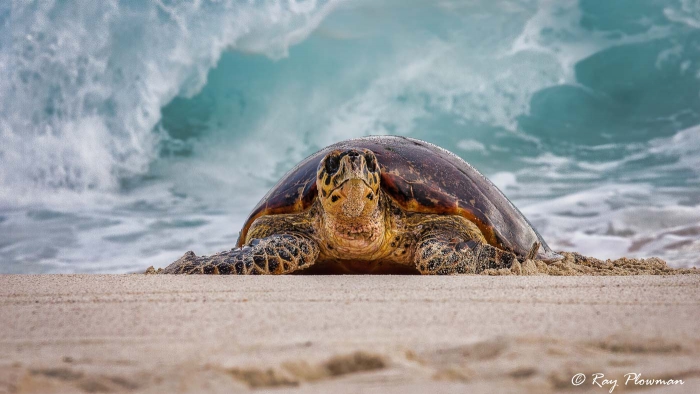
Hawksbill Turtle, Coming Ashore
Hawksbill Turtle (Eretmochelys imbricata) coming ashore at the east end of Mahé Islands Anse Bazarca beach.
Hawksbill Turtles have a decreasing population IUCN Red List (2020-3) assessed critically endangered. On land, they are short-sighted but sensitive to movement around them. They could be susceptible to vibrations and low-frequency sounds. I used a long camera lens of 300 mm and a 70-200 mm telephoto zoom on Canon cameras with APS-C sensors. Thus, I can photograph the turtles from a reasonable distance and minimise disturbance and stress.
First Encounter with Hawksbill Turtles
Our First Hawksbill Turtle Sighing
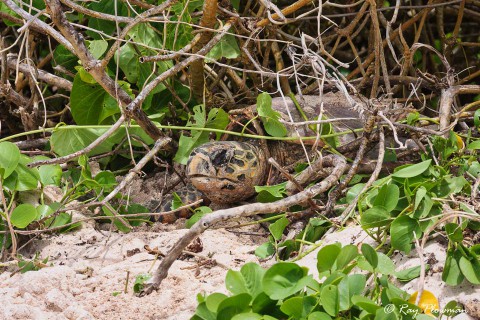
My wife and I were strolling along the west end of Anse Bazarca beach around ten in the morning. We saw a hawksbill turtle headed into the undergrowth to nest. It had already come out of the water and climbed the beach. Several other people were watching from a reasonable distance. After about an hour, the turtle had laid her eggs and then emerged from the undergrowth. She was intent on returning to the sea.
MCSS Data Collection
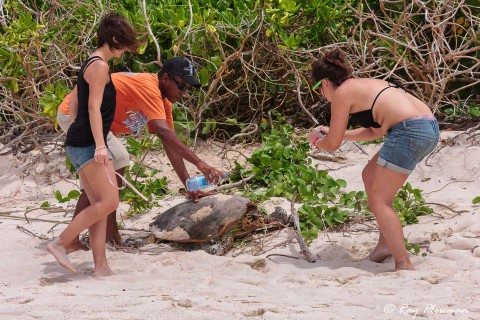
The photo shows a Marine Conservation Society, Seychelles (MCSS) volunteer photographing the turtle before returning to the sea. Volunteers measure the carapace and pour water on its face before taking close-up photographs on both sides of the face. These face images are for identification; the pattern on each turtle is different. The volunteers may also count the number of eggs and mark and log the nest’s position.
Returning to the Sea
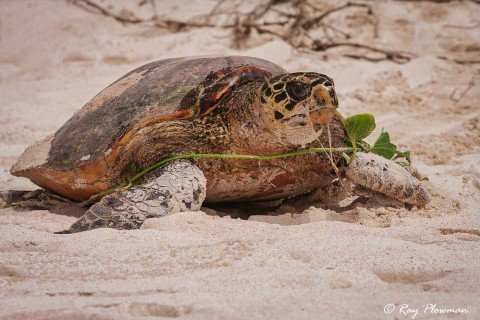
After a few minutes of data collection, the turtle sets off down the beach towards the sea. It took about one-and-a-half hours to climb the beach, dig an egg chamber, lay eggs, and return to the sea. This image shows some vegetation stuck across the turtles’ flippers.
The Seychelles Turtles with MCSS is a website set up to report turtle monitoring activities around Mahé Seychelles by the Marine Conservation Society.
Our Second Sighting
After our first sighting, we visited Anse Bazarca beach three days later. A hawksbill turtle was already nesting in the undergrowth. MCSS volunteers then collected data before the turtle returned to the sea.
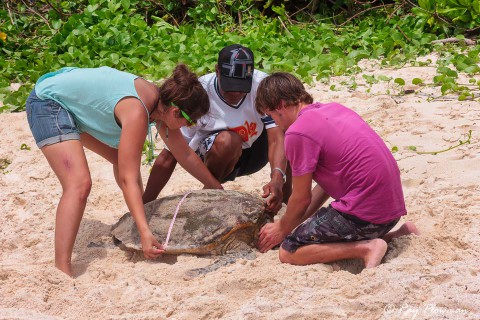
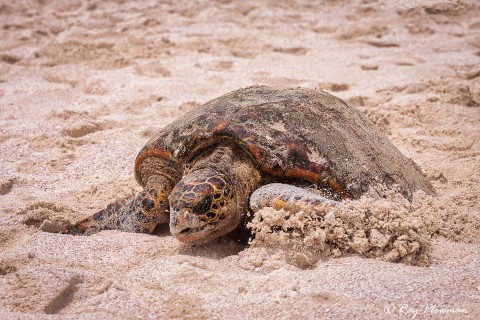
Hawksbill Turtle Nesting Photo Essay
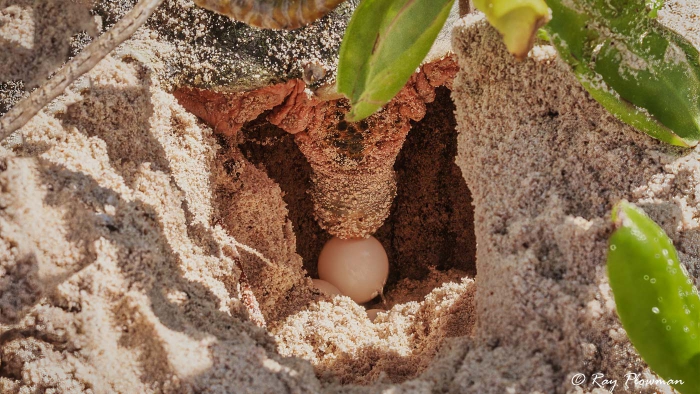
Hawksbill Turtle, Laying Eggs
Hawksbill Turtle (Eretmochelys imbricata) egg laying on Mahé Islands Anse Bazarca beach, Seychelles.
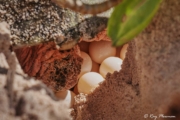
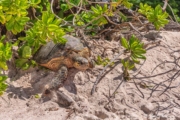
As we were within a few metres of the turtle, we slowly backed off, and I took some photos from the tree line at the back of the beach.
The image sequence shows the turtle crawling up the beach, climbing the sandbank, digging a nest, laying 121 eggs as counted by an MCSS volunteer. One of the volunteers offered me the opportunity to take some photos of egg-laying during the counting process. Then, as on the previous two occasions, they measured and photographed the turtle before returning to the sea.
To turn around, the turtle had to move forward and then sideways. It appeared from the undergrowth a bit further along the sandy bank. Barnacles were hitching a ride on the carapace of this turtle. From leaving the surf to returning to the sea took around on-and-half hours.
About an hour later, a second turtle came ashore, made its way into the undergrowth but returned to the sea without nesting.
A Memorable Day with Hawksbill Turtles
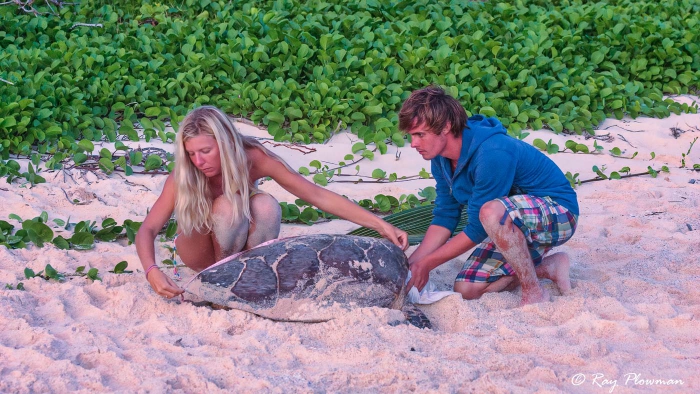
Measuring Hawksbill Turtle
MCSS volunteers measure Hawksbill Turtle at the east end of Anse Bazarca beach.
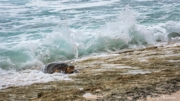
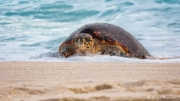
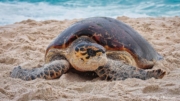
The Start of a Memorable Day
My most memorable day was on 24 November 2011. At lunchtime, we waited in the centre of Anse Bazarca beach for Hawksbill Turtles to come ashore. It is a shady spot opposite the old coral formation in the centre of the beach. I spotted one trying to get across the exposed coral reef. She tried several times but was floundering in the strong surf. Eventually gave up or was frightened off by the movement of some people on the beach.
A couple of hours later, a second turtle came ashore at the west end of the beach. It made its way to the undergrowth but made a hasty retreat to the sea after twelve minutes. Again, people on the beach moving around or something in the undergrowth may have spooked it.
Two Turtles Nesting
Then two hours later, an MCSS volunteer invited us to see a turtle laying eggs at the beach’s east end. I photographed the egg-laying continued to watch from a distance. My wife then spotted another turtle in the surf. There were six of us on the beach, so we all got down as low as possible and froze. I started taking photos as it came out of the surf and towards me but stopped when it was at full frame, about 3 m away. I was lying down when it passed me within touching distance: fantastic, breathtaking wildlife photography at its best.
I took my next image of it heading into the undergrowth as it passed by. Looking at the rear carapace’s markings, I thought it could be the same turtle that came ashore two and a half hours earlier but abandoned nesting on the east end beach. I checked my images, and it was the same turtle choosing to try again on the west end of the beach.
As usual, the volunteers measured and photographed the turtles. Finally, the sun was setting as the turtle returned to the sea, a fitting end to a gratifying and memorable day.
Encounters with More Hawksbill Turtle
Final Day in 2011
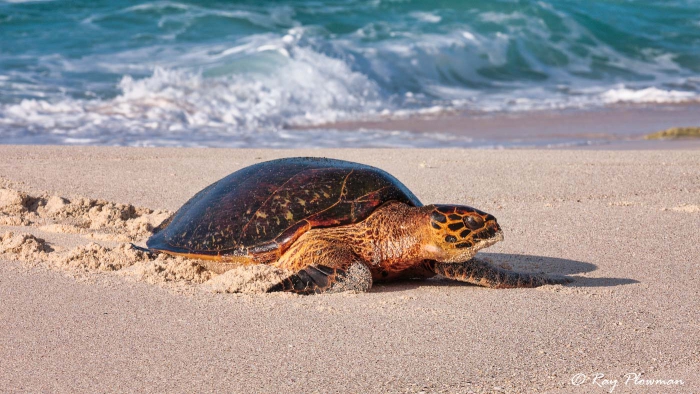
Hawksbill Turtle
Hawksbill Turtle (Eretmochelys imbricata) climbing up the beach on Mahé Islands Anse Bazarca beach in Seychelles.
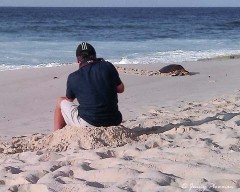
After my experience with the turtle that crawled past me within a touching distance, I did not think I would get better images, but I still wanted to try. So, we went back four days later, but no turtles that day. On our last day on Mahé, we skipped breakfast and arrived at the beach around seven in the morning. I made a small sandcastle on the beach to sit down and wait. It was not long before a turtle came out of the surf; I got some good images of it appearing from the surf. She crawled up the beach and passed within 7 metres but ignored me; I was careful not to move.
I spotted a second turtle at the east end of the beach. It came ashore, went into the undergrowth but gave up its attempt to nest after fifteen minutes, only staying ashore for around 30 minutes. The first turtle successfully nested and returned to the sea after one-and-half hours. Thus, I saw at least three turtles abandoned nesting at this end on the beach.
October 2012 Sightings
On our second visit to Mahé, we only sighted turtles at Anse Bazaar beach on two occasions. On the first, sea conditions were rough, with turtles struggling to get ashore and rocks obstructing their path. However, one successfully nested when the conditions were better before returning to the sea. I have only included two images from our October 2012 trip in the gallery.
Toxic Food
Hawksbill turtles feed mainly on toxic sponges, causing their meat to become contaminated and dangerous. Eating their meat can result in severe illness and death.
















